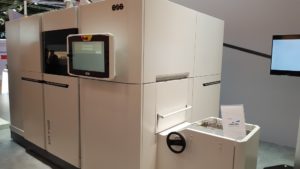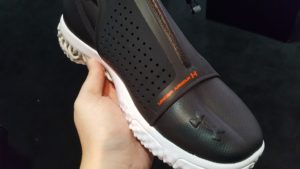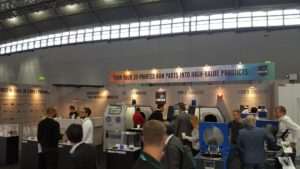 2017 has been a busy year for Germany-based EOS, but the year isn’t over yet as the company continues on its stretch of progress. While the recent formnext event in Frankfurt played host to tens of thousands of visitors and hundreds of exhibitors, EOS made itself heard above the noise of its hall with a well-attended press conference revealing its newest polymer 3D printing system, partnership announcements, and a look into the company’s well-structured vision. EOS continues to work with its expanding network of partners on a variety of applications, from direct metal printing of fine jewelry with Cooksongold to new plastic powder development with BASF, and had a lot to show during the Frankfurt event.
2017 has been a busy year for Germany-based EOS, but the year isn’t over yet as the company continues on its stretch of progress. While the recent formnext event in Frankfurt played host to tens of thousands of visitors and hundreds of exhibitors, EOS made itself heard above the noise of its hall with a well-attended press conference revealing its newest polymer 3D printing system, partnership announcements, and a look into the company’s well-structured vision. EOS continues to work with its expanding network of partners on a variety of applications, from direct metal printing of fine jewelry with Cooksongold to new plastic powder development with BASF, and had a lot to show during the Frankfurt event.
EOS’ industrial 3D printing systems are well known throughout the industry, proving themselves frequently with high user ratings and multi-unit customer investments. While we have heard a great deal from the company regarding their expertise with metal 3D printing technologies and applications, the focus at formnext was largely on polymer technologies and their applications in industry. The company’s installed base of 3D printers are relatively evenly split between the two technologies — about 51% compared to 49% metal systems. During the EOS press conference, company executives addressed several business strategies and approaches to market. EOS GmbH CEO Dr. Adrian Keppler discussed the company’s strategy, beginning with a few key descriptors that together define a great deal of the approach: partners, customer-centricity, innovation with quality, digitalization.
“It took us 20 years to position our first 1,000 units in the market, five years for the next 1,000 printers, and two years for the last 1,000,” Dr. Keppler said of the growth EOS has observed. “Today, our installed base is over 3,000 printers worldwide, with more than 1,500 customers. That is a lot of production technology; we are clearly a market leader. Last year, 450 machines were installed, about 50/50 between polymer and metal. Our aspiration must be that we sell 1,000 systems in the next 12-18 months, and we are preparing ourselves.”
That preparation has been evident as the company has opened a new facility, with a 9,000-square-meter site that can produce more than 1,000 machines per year working one shift. EOS, Keppler said, is “ready in our supply chain to scale up with our bigger customers.” Approximately 200 service technicians are available to support customers through product lifecycles, as the company ensures close and ongoing relationships.
“We are going to integrate additive manufacturing with conventional technologies. Industry 4.0 will support our targets,” Keppler continued. “With our installed base of 3,000 we learn a lot. Many of our customers are world-leading and are qualifying our machines for production as they scale up and leverage the benefits of 3D printing.”
Keppler pointed to the company’s strong network of partners, as EOS collaborates with such software companies as Siemens, Autodesk, and Dassault Systèmes, as well as downstream partnerships for post-processing such as with fellow German company DyeMansion. Throughout the many partnerships, Keppler says that they can “together optimize flow from our printers to coloring and finishing.”
“Partners are important,” he continued, “but we also establish solutions internally. The ecosystem is important.”
Through investment activity, for example, EOS sees that “investing in new technology is interesting for the whole industry.” Keppler additionally pointed to applications and several customer stories.
“At the end, customers want to create value with our machines. It’s about applications at the end, it’s not about the machines — it’s the applicaitons that create value,” Keppler underscored. “This is how we see the future of manufacturing. It’s important that we all grow the market together.”
In discussing this application-driven future, Keppler introduced the newest such activity for EOS as the company teams up with Under Armour. Based on EOS’ latest machine, the polymer P 500 3D printer, which was dramatically revealed with a curtain drop during the press conference, EOS is stepping into footwear, a burgeoning and increasingly busy application for 3D printing technology.
EOS’ Director of Global Application & Consulting, Güngör Kara, noted that the company is working on “more than 300 transformation projects.”
“There is a clear path: find the application, develop or optimize it for additive manufacturing, ramp up production, and certify and scale production,” Kara explained.
Pointing to EOS’ work with Daimler EuroBus as an example of best practice, Kara highlighted that spare parts is a $10 trillion market, of which perhaps $500 billion is addressable by 3D printing. This is a major market opportunity, and manufacturers are taking notice on both the additive manufacturing and automotive sides.
 EOS CTO Dr. Tobias Abeln continued from there, discussing solutions for serial production, especially as they may be relevant with the new polymer 3D printing solution. He noted that there are six primary issues to address:
EOS CTO Dr. Tobias Abeln continued from there, discussing solutions for serial production, especially as they may be relevant with the new polymer 3D printing solution. He noted that there are six primary issues to address:
- Quality of parts
- Productivity
- Quality control
- Size/scalability
- Automation
- Integration
Validation of processes and materials is critical to any technology to be scaled, and is coming more into the limelight as an area of concern for additive manufacturing as newer technologies make their way into production.
Tying together the themes raised during the formnext press conference, this week more details on EOS’ work with Under Armour have come to light as the two companies share a bit more about their partnership, explaining that is intended to develop advanced, scalable laser sintering 3D printing technology. Under Armour has been working with 3D printing technologies for some time, introducing its first approach to incorporating additive manufacturing into shoe production last year with the ArchiTech sneaker. Introduced this spring, the ArchiTech Futurist features a 3D printed midsole.
“With EOS’ industry-leading laser sintering 3D printing technology, Under Armour can deliver shoes to the marketplace in a meaningful way, creating truly amazing, desirable products which solve our customers’ needs in ways that could have never been imagined before,” said Clay Dean, Chief Innovation Officer, Under Armour. “Together, our two organizations make a formidable pair.”
The strategic partnership builds on both companies’ “vision to advance commercial 3D printed footwear,” says the latest announcement. Through this partnership, EOS and Under Armour are set to collaborate on development of polymer powder and an advanced laser sintering platform. EOS’ Additive Minds service will also work with Under Armour to further advance its additive manufacturing program and focus. The intention is for scale production of performance footwear incorporating 3D printed elements.
Back in Frankfurt, I had the opportunity to check out an ArchiTech Futurist shoe up close, as over coffee DyeMansion CEO Felix Ewald told me a bit about the process of finding just the right shade of grey for the midsole. Close collaboration with all partners is critical as the pieces come together in ambitious designs like these for mass-produced commercial shoes, and DyeMansion has been working in concert with EOS and Under Armour to ensure all the parts fit seamlessly for one cohesive design.
Discuss these announcements and other 3D printing topics at 3DPrintBoard.com or share your thoughts in the Facebook comments below.
[Photos: Sarah Goehrke]
Subscribe to Our Email Newsletter
Stay up-to-date on all the latest news from the 3D printing industry and receive information and offers from third party vendors.
You May Also Like
Why Corrosive Resistant Materials Are Important to the Success of 3D Printing Across Industries
The adoption of additive manufacturing (AM) is accelerating across many major industries. As this technological shift unfolds, the importance of corrosion resistance has emerged as a challenge for 3D printing...
America Makes Announces IMPACT 2.0: $6.6M in New 3D Printing Funding
America Makes, the Manufacturing Innovation Institute (MII) based in Youngstown, Ohio, has announced IMPACT (Improvement in Manufacturing Productivity via Additive Capabilities and Techno-Economic Analysis) 2.0, a project call which will...
3D Printing Webinar and Event Roundup: April 14, 2024
We’re starting off the week’s 3D printing webinars and events at ASTM AMCOE’s 11th Snapshot Workshop and MACH Exhibition. Stratasys continues its advanced training courses, SME is holding a virtual...
AMUK Welcomes Airframe Designs as British 3D Printing Industry Grows
While the UK is not the hub for 3D printer and materials manufacturers as other nations, the country continues to excel at the research, development, and application of additive manufacturing...











































